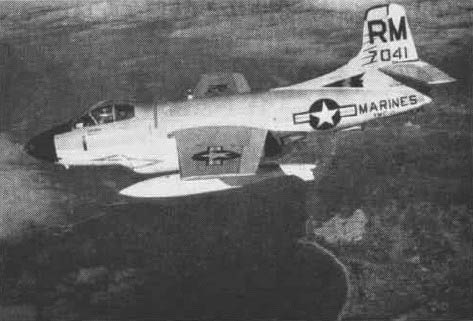U.S. NAVAL AVIATION RESOURCE CENTER > FIGHTERS > PREVIOUS PAGE
Operational History
In the years after the Korean War, the F3D was gradually replaced by more powerful aircraft with better radar systems. The F3D's career was not over though; its stability and spacious fuselage made it easily adaptable to other roles. The F3D (under the designations F3D-1M and F3D-2M) was used to support development of a number of air-to-air missile systems during the 1950s, including the Sparrow I, II, and III and Meteor missiles.
The F3D-2M was the first operational Navy jet aircraft to be fitted with an air-to-air missile, the Sparrow I, a missile that used beam riding guidance for the aircrew to control the flight of the missile. Only 38 aircraft (12 F3D-1Ms, and 16 F3D-2Ms) were made able to use the missiles.
In the late 1950s, a number of the Marine F3D-2 aircraft were re-configured as electronic warfare aircraft and were designated F3D-2Q (later EF-10B). Also, a few aircraft were converted for use as trainers and were designated F3D-2T.

Douglas EF-10B Skyknight (Bu 127041) of VMCJ-1 over Vietnam in 1965/66.
[Source: USN]
When the U.S. Navy issued a requirement for a fleet defense missile fighter in 1959, Douglas responded with the F6D Missileer, essentially an updated and enlarged F3D that would carry the AAM-N-10 Eagle long-range missile with the most important characteristics being able to carry a large load of fuel, long time-on-station, crew of two, and sophisticated electronics rather than speed or maneuverability. This concept which kept the straight wings in an age of supersonic jets was soon cancelled because it would not be able to defend itself against more nimble fighters. Its weapon system would be adapted for the supersonic swing-wing General Dynamics/Grumman F-111B which also specified side-by-side seating, but would also prove vulnerable to MiGs. The AWG-9/Phoenix and TF30 turbofan engine (with afterburner) would eventually reach service on the F-14 Tomcat which could swing its wing straight forward for loiter.
The unusual portly profile earned it the nickname "Willie the Whale". It is less clear how it also came to be known "drut." It should be noted, however, that "Drut" is "Turd" spelled backward.
Sources:
Wikipedia: Douglas F3D Skyknight
U.S. NAVAL AVIATION RESOURCE CENTER > FIGHTERS > PREVIOUS PAGE
